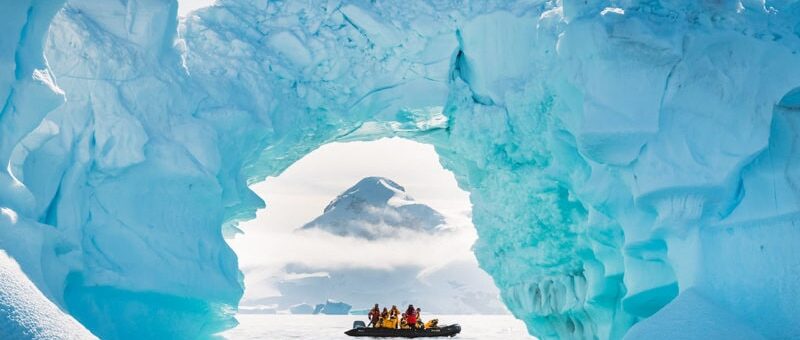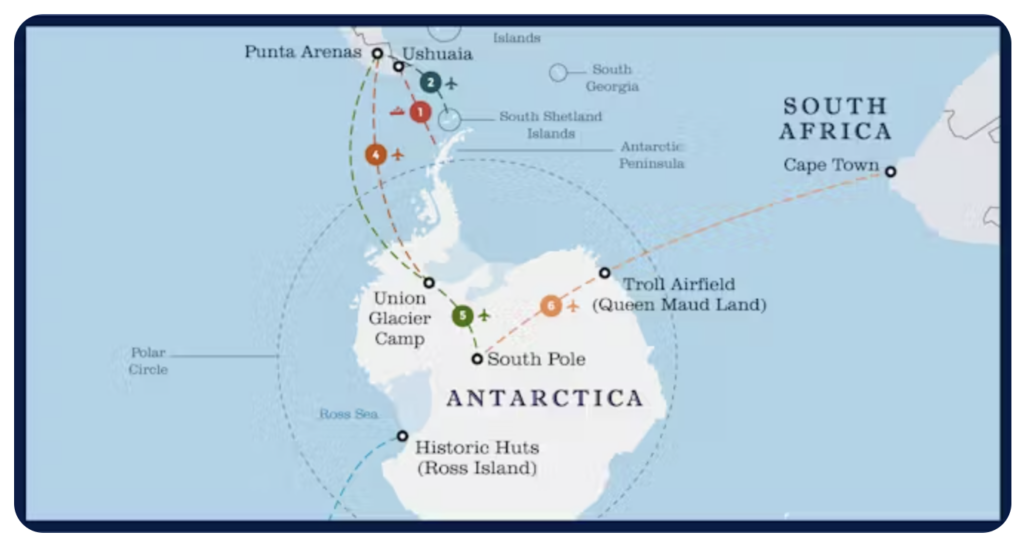
Antarctica Flights – What You Need to Know
How to Get to the South Pole
APRIL 2025
Spanning an Area of Nearly 5.4 Million Square Miles
Antarctica is this planet’s southernmost continent, embedded almost entirely south of the Antarctic Circle, totally flanked by the Southern Ocean. As the fifth-largest continent, it spans an area of nearly 5.4 million square miles, coming in at close to twice the size of Australia. The continent is perhaps best known for its extremely frigid cold temperatures and harsh weather conditions, as well as its uniquely rare ecosystems.
Officially First Discovered
The region’s history is marked by brave exploration and scientific discovery. While some ancient civilizations may have been aware of Antarctica’s existence, the continent was officially first discovered in 1820 by a Russian expedition team led by Fabian Gottlieb von Bellingshausen and Mikhail Lazarev. Throughout the 19th and early 20th centuries, several explorers, including James Clark Ross, Ernest Shackleton, and Robert Falcon Scott, embarked on daring journeys to trek, map, and better understand such an inhospitable and icy land.
Reaching the South Pole
During the early 20th century, often referenced as the “Heroic Age of Antarctic Exploration,” there were intense efforts worldwide to chart, explore, and claim sections of the barren continent. Notable expeditions during this time aimed to reach the South Pole, which Roald Amundsen of Norway achieved in 1911, shortly before Scott’s British team perished on their return journey.
Banning All Military Activity
In 1959, the Antarctic Treaty was signed into law by a dozen nations, establishing Antarctica as a protected scientific preserve and effectively banning all military activity on the continent. This treaty, which has to date been signed by several additional countries, encourages international scientific cooperation regarding research and environmental issues.
Scores of Temporary Inhabitants
The icy contentment does not have any indigenous populations or permanent residents of note. The only human presence are the scores of temporary inhabitants—scientists and support teams who live in lunar-style housing designed for research purposes. The population changes seasonally, with approximately 1,000 people on site in winter and upwards of 4,000 during the summer months when conditions are more welcoming.
A Host of Nations
There are about 70 research stations dotted across Antarctica, operated by a host of nations, including the United States, Russia, China, Argentina, and Australia. These research facilities conduct experiments in fields related to glaciology, meteorology, biology, and climate change. The largest research station is the United States’ McMurdo Station, which serves as a primary logistical hub for the bulk of most scientific work.
A Growing Number of Flights
Most Antarctic visitors travel back and forth by ship, which involves four days at sea and takes overall a minimum of 10 days. That said, there is a small yet growing number of flights to and from Antarctica that will transport travelers there in just a few hours. Note that there are no regular scheduled flights to Antarctica.
Short Antarctic Flying Season
The only sightseeing flights for tourists are charter flights, which can only be purchased as part of a package, unlike, for example, booking a seat on a regularly scheduled commercial flight. Despite the rather short Antarctic flying season (late November to early March) and no regular scheduled flights, there is overall a good range of travel options to choose among.
Rapidly Changing Weather
Different from ship-based cruises, which are limited to only exploring the coastline, flights into the interior of Antarctica make it possible to explore Antarctica’s vast landmass, including even the South Pole. Harsh, frigid, and rapidly changing weather patterns make flying challenging, unpredictable, susceptible, and often subject to delays. The advantage of flying comes with a tradeoff between greater convenience and heightened levels of risk.
Charter Flights
Many flights originate from southern Chile, requiring two hours to reach Antarctica. These flights operate from late November until around early March. Today, charter flights to the Antarctic Peninsula as well as the South Pole are becoming increasingly popular. Many wishing to avoid the Drake Passage choose a flight from Punta Arenas or Puerto Natales as the best option to experience the greatness of Antarctica.
Harsh Weather Conditions
The Drake Passage is found lurking between the southern tip of South America and Antarctica and is considered one of the world’s most treacherous maritime routes. Covering about 500 miles, it joins the Atlantic and Pacific Oceans, serving as the vital gateway for vessels enroute to Antarctica. The passage is dangerous with its unforgiving weather conditions, characterized by extremely strong winds, towering waves, and quickly changing weather.
Turbulent Waters
For sea ships bound for Antarctica, the Drake Passage poses significant hazards and challenges, including choppy seas and sub-zero temperatures, which greatly increase the potential for accidents and vessel system failures. The turbulent waters typically cause severe motion sickness among passengers while also complicating navigation, resulting in a journey that is physically exhausting and hazardous. These obstacles support the passage’s reputation as one of the most formidable maritime routes anywhere in the world.
British Aerospace
The BAE-146 is the most common aircraft used for these flights with its four powerful turbofan engines. It has the capacity to seat up to 80 people and has a reinforced undercarriage for remote airstrip landings. The BAe 146 was developed by British Aerospace in the 1980s. It is a regional jet transport aircraft known for its quiet and efficient operation and high-wing construction. Designed for medium- to short-haul flights, it became popular for its ability to operate from short, rough, and unpaved runways, making it ideal for Antarctica flights.
Specialized Missions
The aircraft typically seats 70 or more passengers, with a range of approximately 1,000–1,250 miles. The airplane’s primary mission is focused on efficient, reliable air travel, balancing performance with environmental considerations. The BAe 146 has also been used for commercial cargo and specialized missions, including operations into remote and extreme locations just like Antarctica.
Video
Here is a great YouTube video that shows what it is like to actually fly to Antarctica. If you are considering a trip to Antarctica, the town of Punta Arenas in southern Chile is the most used point of departure. King George Island and South Shetland Islands are the only commercial airfield servicing the Antarctic Peninsula for those wishing to visit.
The Interior of Antarctica
In addition, scheduled flights to the Falkland Islands with a flying time of just over 90 minutes are offered once weekly with flights to Stanley, the capital of the Falklands. There are charter flights deep into the interior of Antarctica, landing at Union Glacier basecamp, requiring a flying time of about four hours. For those daring enough to trek to the South Pole, there are ‘blue ice runways’ that accommodate aircraft using a combination of skis and wheels depending on existing weather conditions.
Suitable Types of Equipment
In addition to the workhorse BAE-146 aircraft, there are several other suitable types of equipment that are equally capable of making the journey to Antarctica. These include the soviet-designed and built Ilyushin IL-76 TD, the smaller workhorse, De Haviland DHC-6 Twin Otter, as well as the Basler BT-67 (essentially a modified DC-3), and others.
Flights Delays Are a Fact of Life Here
Low level clouds, thick fog, and strong winds are the main factors in causing delays. In fact, King George Island is perhaps most prone to dense fog and low cloud decks. To safely depart from and return to Punta Arenas, pilots landing visually in Antarctica require a minimum 5-hour window of favorable weather. Due to rapidly changing weather conditions, pilots are tasked with the challenge of successfully identifying this critical ‘weather window’ to complete a full journey out and back.
The Actual Expedition
A typical Antarctica tourist expedition delivers a once-in-a-lifetime experience within the earth’s most remote and pristine ecosystem. Many tours start with a voyage across the Drake Passage, where passengers are up close and personal in crossing the turbulent waters while keeping an eye out for whales and seabirds. Upon arrival, those on expedition can explore the Antarctic Peninsula, the continent’s most accessible region, often aboard reenforced ice-strengthened ships designed for the rugged polar conditions.
Zodiac Boating Excursions
Witness the breathtaking landscapes of massive, towering icebergs, endless glaciers, and snow-packed mountains. Wildlife encounters are clearly a highlight, where opportunities abound to observe penguins, seals, and various seabird species up close. Some more extreme expeditions include Zodiac boating excursions, allowing passengers to navigate icy waters and land on the continent’s jagged shores for expertly guided walks and wildlife viewing.
A Fascinating History
Activities can also include visits to fully operational research stations, where visitors learn about ongoing scientific work, as well as educational presentations about Antarctica’s unique environment and fascinating history. For the more adventurous, kayaking, ice hiking, and even polar ice water plunges are an option. This once-in-a-lifetime experience combines awe-inspiring natural beauty with educational insights, leaving visitors with timeless memories of this icy, out-of-this-world kind of place.
Visit Swoop Antarctica to learn more or to book a trip.
